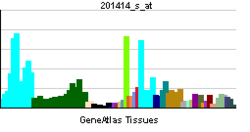- NAP1L4
-
Nucleosome assembly protein 1-like 4 Identifiers Symbols NAP1L4; MGC4565; NAP1L4b; NAP2; NAP2L; hNAP2 External IDs OMIM: 601651 MGI: 1316687 HomoloGene: 90892 GeneCards: NAP1L4 Gene Gene Ontology Molecular function • unfolded protein binding Cellular component • nucleus
• chromatin assembly complex
• cytoplasmBiological process • nucleosome assembly Sources: Amigo / QuickGO RNA expression pattern 
More reference expression data Orthologs Species Human Mouse Entrez 4676 17955 Ensembl ENSG00000205531 ENSMUSG00000059119 UniProt Q99733 Q8C1W9 RefSeq (mRNA) NM_005969 NM_008672.2 RefSeq (protein) NP_005960 NP_032698.1 Location (UCSC) Chr 11:
2.97 – 3.01 MbChr 7:
150.7 – 150.73 MbPubMed search [1] [2] Nucleosome assembly protein 1-like 4 is a protein that in humans is encoded by the NAP1L4 gene.[1][2]
This gene encodes a member of the nucleosome assembly protein (NAP) family which can interact with both core and linker histones. It can shuttle between the cytoplasm and nucleus, suggesting a role as a histone chaperone. This gene is one of several located near the imprinted gene domain of 11p15.5, an important tumor-suppressor gene region. Alterations in this region have been associated with the Beckwith-Wiedemann syndrome, Wilms tumor, rhabdomyosarcoma, adrenocortical carcinoma, and lung, ovarian, and breast cancer.[2]
References
- ^ Hu RJ, Lee MP, Johnson LA, Feinberg AP (Mar 1997). "A novel human homologue of yeast nucleosome assembly protein, 65 kb centromeric to the p57KIP2 gene, is biallelically expressed in fetal and adult tissues". Hum Mol Genet 5 (11): 1743–8. doi:10.1093/hmg/5.11.1743. PMID 8923002.
- ^ a b "Entrez Gene: NAP1L4 nucleosome assembly protein 1-like 4". http://www.ncbi.nlm.nih.gov/sites/entrez?Db=gene&Cmd=ShowDetailView&TermToSearch=4676.
Further reading
- Rodriguez P, Munroe D, Prawitt D, et al. (1997). "Functional characterization of human nucleosome assembly protein-2 (NAP1L4) suggests a role as a histone chaperone.". Genomics 44 (3): 253–65. doi:10.1006/geno.1997.4868. PMID 9325046.
- Rodriguez P, Pelletier J, Price GB, Zannis-Hadjopoulos M (2000). "NAP-2: histone chaperone function and phosphorylation state through the cell cycle.". J. Mol. Biol. 298 (2): 225–38. doi:10.1006/jmbi.2000.3674. PMID 10764593.
- Shikama N, Chan HM, Krstic-Demonacos M, et al. (2000). "Functional interaction between nucleosome assembly proteins and p300/CREB-binding protein family coactivators.". Mol. Cell. Biol. 20 (23): 8933–43. doi:10.1128/MCB.20.23.8933-8943.2000. PMC 86548. PMID 11073993. http://www.pubmedcentral.nih.gov/articlerender.fcgi?tool=pmcentrez&artid=86548.
- Cicala C, Arthos J, Selig SM, et al. (2002). "HIV envelope induces a cascade of cell signals in non-proliferating target cells that favor virus replication.". Proc. Natl. Acad. Sci. U.S.A. 99 (14): 9380–5. doi:10.1073/pnas.142287999. PMC 123149. PMID 12089333. http://www.pubmedcentral.nih.gov/articlerender.fcgi?tool=pmcentrez&artid=123149.
- Strausberg RL, Feingold EA, Grouse LH, et al. (2003). "Generation and initial analysis of more than 15,000 full-length human and mouse cDNA sequences.". Proc. Natl. Acad. Sci. U.S.A. 99 (26): 16899–903. doi:10.1073/pnas.242603899. PMC 139241. PMID 12477932. http://www.pubmedcentral.nih.gov/articlerender.fcgi?tool=pmcentrez&artid=139241.
- Ota T, Suzuki Y, Nishikawa T, et al. (2004). "Complete sequencing and characterization of 21,243 full-length human cDNAs.". Nat. Genet. 36 (1): 40–5. doi:10.1038/ng1285. PMID 14702039.
- Rodriguez P, Ruiz MT, Price GB, Zannis-Hadjopoulos M (2005). "NAP-2 is part of multi-protein complexes in HeLa cells.". J. Cell. Biochem. 93 (2): 398–408. doi:10.1002/jcb.20163. PMID 15368365.
- Gerhard DS, Wagner L, Feingold EA, et al. (2004). "The status, quality, and expansion of the NIH full-length cDNA project: the Mammalian Gene Collection (MGC).". Genome Res. 14 (10B): 2121–7. doi:10.1101/gr.2596504. PMC 528928. PMID 15489334. http://www.pubmedcentral.nih.gov/articlerender.fcgi?tool=pmcentrez&artid=528928.
- Nousiainen M, Silljé HH, Sauer G, et al. (2006). "Phosphoproteome analysis of the human mitotic spindle.". Proc. Natl. Acad. Sci. U.S.A. 103 (14): 5391–6. doi:10.1073/pnas.0507066103. PMC 1459365. PMID 16565220. http://www.pubmedcentral.nih.gov/articlerender.fcgi?tool=pmcentrez&artid=1459365.
- Olsen JV, Blagoev B, Gnad F, et al. (2006). "Global, in vivo, and site-specific phosphorylation dynamics in signaling networks.". Cell 127 (3): 635–48. doi:10.1016/j.cell.2006.09.026. PMID 17081983.
Categories:- Human proteins
- Chromosome 11 gene stubs
Wikimedia Foundation. 2010.
